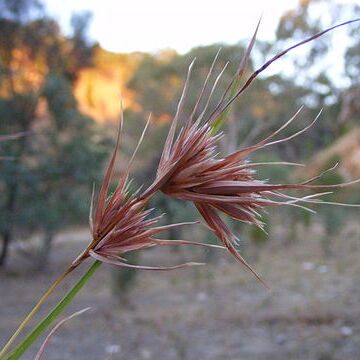Annuals or perennials. Leaf-blades linear; ligule very short, membranous. Inflorescence composed of solitary racemes embraced by sheathing spatheoles, these single or in little bunches on flexuous peduncles, and gathered into a leafy false panicle; racemes comprising 2 homogamous pairs forming a sort of involucre, and 1–4 sessile spikelets with their pedicelled attendants; internodes linear. Homogamous spikelets all sessile, persistent. Sessile spikelet terete; callus obtuse to pungent; lower glume coriaceous, rarely grooved, obtuse; lower floret reduced to a hyaline lemma; upper lemma stipitiform and passing directly into a puberulous or pubescent awn, or hyaline and awnless. Caryopsis lanceolate, channelled on one side. Pedicelled spikelet ♂ or barren, narrowly lanceolate, awnless, with a long slender callus as long as or longer than the true pedicel (this often reduced to a little stump).
Inflorescence composed of solitary racemes embraced by colourful sheathing spatheoles, the racemes single or more often densely packed in fan-shaped clusters on a flexuous peduncle and gathered into a leafy false compound panicle; racemes comprising 2 homogamous spikelet pairs forming a sort of involucre, and 1–4 sessile spikelets with their pedicelled attendants; internodes linear.
Sessile spikelet terete or dorsally compressed; callus obtuse to pungent; inferior glume coriaceous, not grooved, obtuse at the apex; inferior floret reduced to a hyaline lemma; superior lemma stipitiform and passing directly into a puberulous or pubescent awn, or hyaline and awnless.
Pedicelled spikelet male or barren, narrowly lanceolate, awnless, with a long slender callus as long as or longer than the true pedicel (this often reduced to a little stump).
Homogamous spikelets all sessile, the pairs separated by a short internode, persistent.
Ligule very short, membranous; leaf laminas linear.
Caryopsis lanceolate, channelled on one side.
Annuals or perennials.

